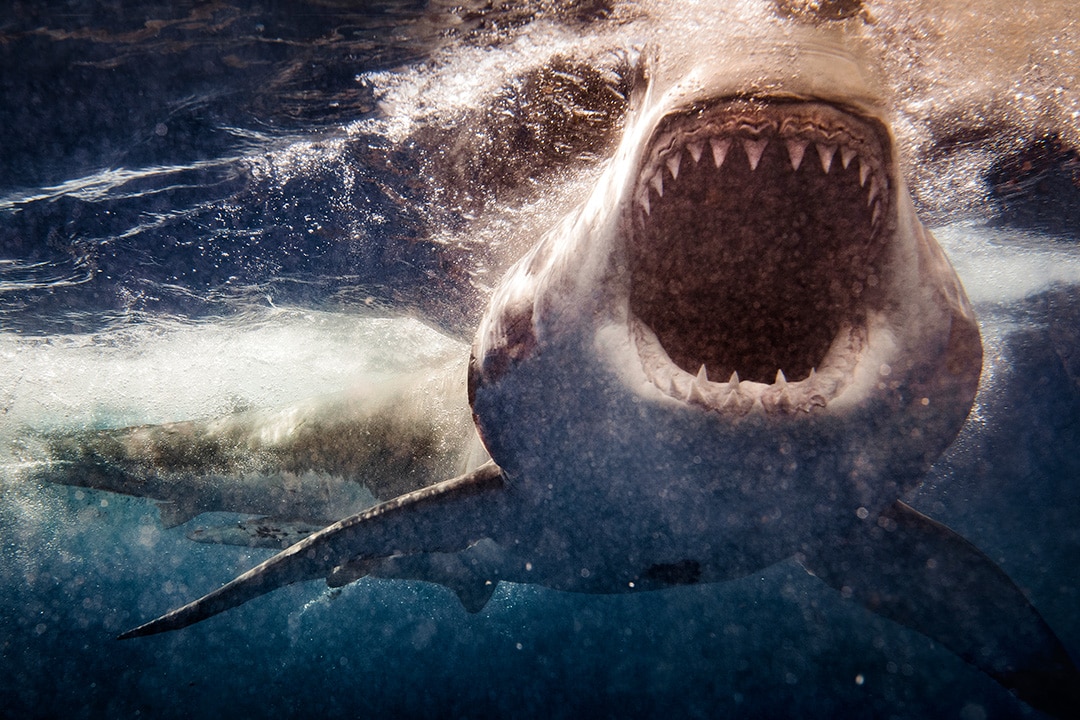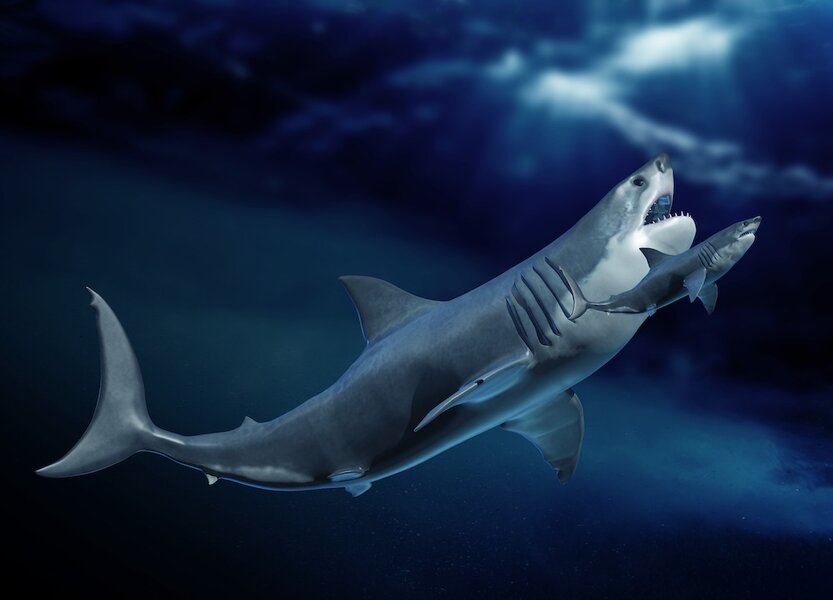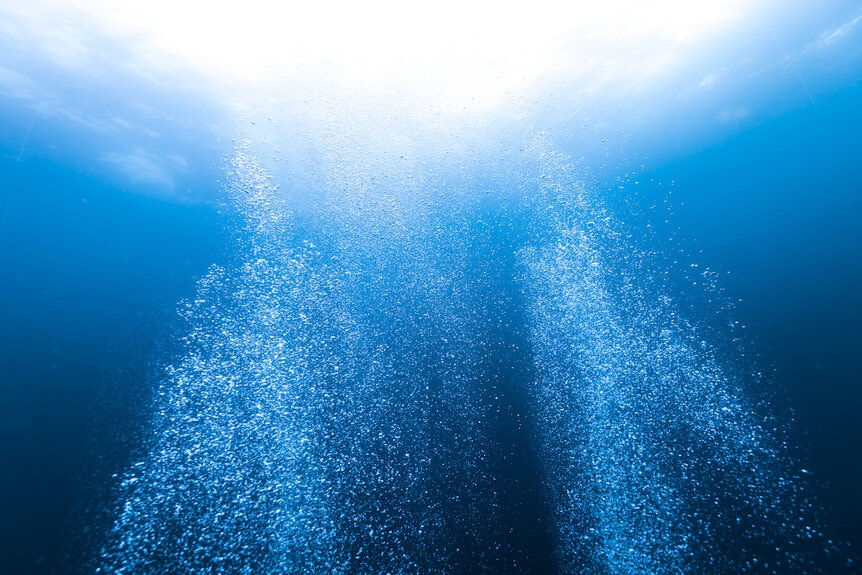Create a free profile to get unlimited access to exclusive videos, sweepstakes, and more!
No, NASA Doesn't Have a Live Megalodon Hidden in the Atlantic Ocean
Sure would be cool if they did, though.

Troubled and troublesome depression-era filmmaker Carl Denham (Jack Black) would do just about anything to achieve fame and success. That’s why in Peter Jackson's 2005 adaptation of King Kong (streaming now on Peacock) he tricks a film crew, a writer, actors, and the crew of a ship into sailing for the legendary Skull Island.
There, tucked into a hidden corner of the world’s oceans, they find a world filled with gigantic, prehistoric creatures. We’re fairly confident that here in the real world there aren’t any hidden islands out there where dinosaurs and giant apes still roam their small patch of ground, but there could be just about anything hiding in the ocean deep.
RELATED: Great White Sharks Have a Mysterious Second Life in the Ocean's Twilight Zone
Is it possible that one or more megalodons (a monstrous shark from Earth’s past) are still roaming the ocean? And might the United States government have captured one in the ‘70s? These are some of the (admittedly silly) questions floating around on the internet. A recent viral TikTok claims that NASA of all places captured a megalodon half a century ago and they’ve been holding it in a gigantic tank in the Atlantic. In short, the video claims that a man named George Meyer found a giant underwater cage in the Atlantic and spied a 70-foot shark inside. That’s pretty obviously untrue, but let’s break down why.
TikTok Video Claims NASA Is Hiding a Living Megalodon
Our first clue that we shouldn’t trust the video is the way it’s composed. Information is delivered through voiceover, played over a series of images. Every image in the video is a stock photo or an image lifted from the internet. There is no original content presented, every element of the story from where it happened, who was involved, and what (if anything) was found, has to be taken on faith. Woof. What are those claims, exactly. We’re glad you asked.
NASA Was Involved in Oceanic Research in the ‘70s
This one is pretty straightforward and happens to be true. Every good lie is built on at least a nugget of truth, and this is our nugget. For clarity, NASA stands for National Aeronautics and Space Administration and as the name suggests, most of the organization’s activities take place in the air or in space.
However, understanding the Earth is key to understanding the cosmos, and you can’t understand the Earth without studying the oceans. NASA has studied the oceans throughout its history and continues to study them today.
NASA Built a Large Underwater Enclosure in the Atlantic
The video claims that in the course of NASA’s early oceanic research, they built a massive underwater cage in the North Atlantic, off the coast of Maryland. The voiceover also states that this cage is located in an area known as Zone F.
There is zero evidence of anything called Zone F. It seems to be an invention of the video-maker, if you search for Zone F online, you’re likely to only find the above TikTok or other people talking about it. If the U.S. Government has a secret underwater Area 51, they’ve done a super good job of hiding it. The ocean does have a number of zones which scientists and even government officials might talk about, but they have names like “mesopelagic” and they don’t have anything to do with top secret research.
RELATED: Megalodon Could Have Eaten a Killer Whale Whole
As for a gigantic cage, the video claims it was visible through the water from the surface and descended hundreds of feet (more on that later). Even if we assume someone did build a secret cage in the ocean, why would it be visible from the surface? The fact that it could be easily discovered aside, a massive metal structure that close to the surface would be a potentially deadly hazard to any ships in the area.
The Cage Was Discovered by Diver George Meyer After a Storm
When George Meyer is introduced to the narrative, viewers are shown the image of a guy holding a fish, but that’s not George Meyer. That’s just some guy. Later, we’re told that George was on a fishing trip when his boat was caught up in a storm that washed him out into the open ocean on April 17, 2023. That’s where he found a cage just beneath the surface.
First things first, George Meyer doesn’t seem to exist. Sure, there are plenty of George Meyers out there (apologies to all of them for the unwanted attention) but none of them are associated with that image and none of them are documented divers of any note.
What about the storm? It must have been a pretty big one to carry him so far out to sea. Must have been the kind of storm you’d read about; the kind of storm that might be documented somewhere. This year was fairly active in terms of hurricanes and tropical storms in the Atlantic. There were 20 named storms in the Atlantic this year, but none occurred on or around April 17.
The Megalodon Cage Descended Hundreds of Feet Down
Aside from trying to convince us that megalodons still exist, this is the weirdest claim in the video. Allegedly, George Meyer strapped on his scuba gear and jumped into the water. He followed the cage down and down but never saw a bottom. Eventually, he hit a depth of 600 feet, couldn’t go any farther, and returned to the surface.
Six hundred feet might not sound like much but let’s get our bearings. Recreational diving, the kind that ordinary people do, has a maximum depth of 40 meters or about 130 feet. The average diver wouldn’t go deeper than that and certainly not alone. Beyond the 40-meter mark you enter the realm of technical diving. Trained divers can get pretty deep but the deeper you go the more complicated things get and even they wouldn’t make a 600-foot dive on a whim.
RELATED: Great whites might have pushed megalodons toward extinction
Because of the pressures involved, gasses start to do weird stuff inside your body. As you dive, pressure builds up around your body and the nitrogen in your blood and tissues starts to dissolve, just like the carbon dioxide inside a closed can of soda. When divers come up too quickly it’s like opening the can. The pressure drops rapidly and the previously dissolved gas expands and forms bubbles. The sudden appearance of gas bubbles in your blood and tissues can cause serious internal trauma. Divers have to ascend slowly and carefully to prevent decompression sickness.
At the depths recreational divers dive to, decompression is less of a concern, but at 600 feet it’s significant. The amount of time needed for decompression depends on the depth, how long you were down there, the gas mixtures you’re using, and whether you’ve done any recent dives. That’s because it can take days for your body to return to background gas levels, so the effects can accumulate. When Ahmed Gabr broke the scuba diving depth record by diving to 332.35 meters (1090 feet) it took him 14 minutes to get down and 14 hours to get back up.
So Does NASA Have a Secret Megalodon Hidden in the Atlantic Ocean?
No.
Catch King Kong streaming now on Peacock.

















